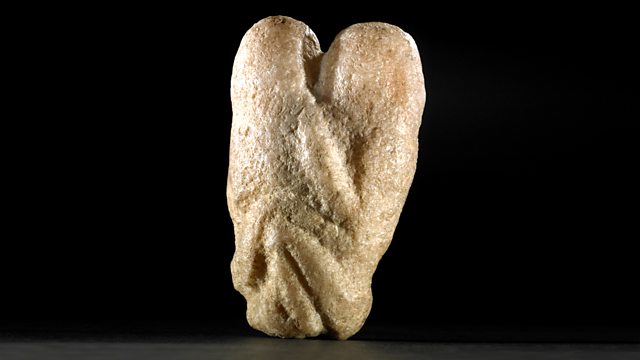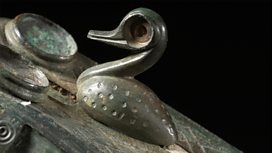Ain Sakri Lovers Figuerine
Neil MacGregor continues his history of the world through objects - one of the earliest depictions of sex in art - a tiny stone sculpture 11,000 years old
The British Museum's Director, Neil MacGregor, investigates a palm-sized stone sculpture that was found near Bethlehem. It clearly shows a couple entwined in the act of love. The contemporary sculptor Marc Quinn responds to the stone as art and the archaeologist Dr Ian Hodder considers the Natufian society that produced it. What was human life and society actually like all those years ago? Possibly a lot more sophisticated than we imagine!
Last on
![]()
Discover more programmes from A History of the World in 100 Objects about food and farming
About this object
Location: Khareitoun, Judea
Culture: Early People
Period: 11,000 years old
Material: Stone
Ìý
This is the oldest known representation of a couple making love in the world. It was found in a cave in the Judean desert. The pebble depicts a couple face to face. One person has wrapped their arms around the shoulders of their lover in an embrace. The knees of one of the figures bend up over the legs of the other. The pebble has been ingeniously carved so that, whichever way you look at it, the shape of the figurine is phallic but the genders of the couple are not revealed.
What was the sculpture used for?
The people who made the figurine are known as Natufians and are among the first people to domesticate sheep and goats. Selectively breeding animals required an understanding of the male role in reproduction and the sculpture's phallic shape may reflect their interest in fertility. Was this work of art used for rituals focussed on fertility or is it simply a reflection on human love?
Did you know?
- The Natufians were hunter-gatherers whose lifestyle gradually led to farming.
The difference between art and artefact
By Marc Quinn, Artist
Ìý
An artefact is something from a particular time that stays in that time like a piece of pottery and it becomes like a relic of that time. An artwork is something that is from a time but is also eternally in the present moment and I think you can definitely say that this sculpture is in the present moment.
That to me is the great strength of making artwork, you are making essentially emotional time machines. You’re making an object of meditation that will communicate with people in 10,000 years time (were it to survive) in a very direct way – I mean certain things are beyond time!
Who were the Ain Sakhri lovers?
By Jill Cook, Curator, British Museum
Ìý
A work of art may be appreciated across cultures and millennia because it expresses something which we can recognize on our own terms.
Whether we see the Ain Sakhri lovers as a piece of erotica, a tender expression of homosexual or heterosexual love, a symbol of fertility, masculinity or a metaphor for creation, depends on our own background and beliefs. As we enjoy the ingenious composition and skilful artistry, we connect our present to its deep past and a period of significant transformation in human history.
11,000 years ago the Natufian people of the Middle East lived by hunting gazelle with their pet dogs. Gazelle have fixed territories so where it was also possible to collect seasonally abundant figs, acorns, pistachios, as well as wild lentils, chick peas and wheat grains, these hunter gatherers could stay longer in one place allowing some permanently occupied villages to develop.
Although it was probably only a temporary shelter, even the toolkit from the cave of Ain Sakhri includes little flint blades which slotted into the wooden handles of reaping knives. By gathering wild wheat and barley, Natufian gatherers were preferring strains which did not release their grains in the slightest gust of wind.
This accidental process of selection began the slow genetic modification of cereals which enabled the growing of crops Sheep, goats, cattle and pigs were also gradually domesticated from wild species for farming. Like Adam and Eve, the lovers’ descendents, particularly the women, faced a future of hard labour in fields.
Transcript
Broadcasts
- Tue 26 Jan 2010 09:45±«Óãtv Radio 4 FM
- Tue 26 Jan 2010 19:45±«Óãtv Radio 4
- Wed 27 Jan 2010 00:30±«Óãtv Radio 4
- Tue 21 Apr 2020 13:45±«Óãtv Radio 4
Featured in...
![]()
Food and Farming—A History of the World in 100 Objects
A History of the World in 100 objects - Food and farming
Podcast
-
![]()
A History of the World in 100 Objects
Director of the British Museum, Neil MacGregor, retells humanity's history through objects





